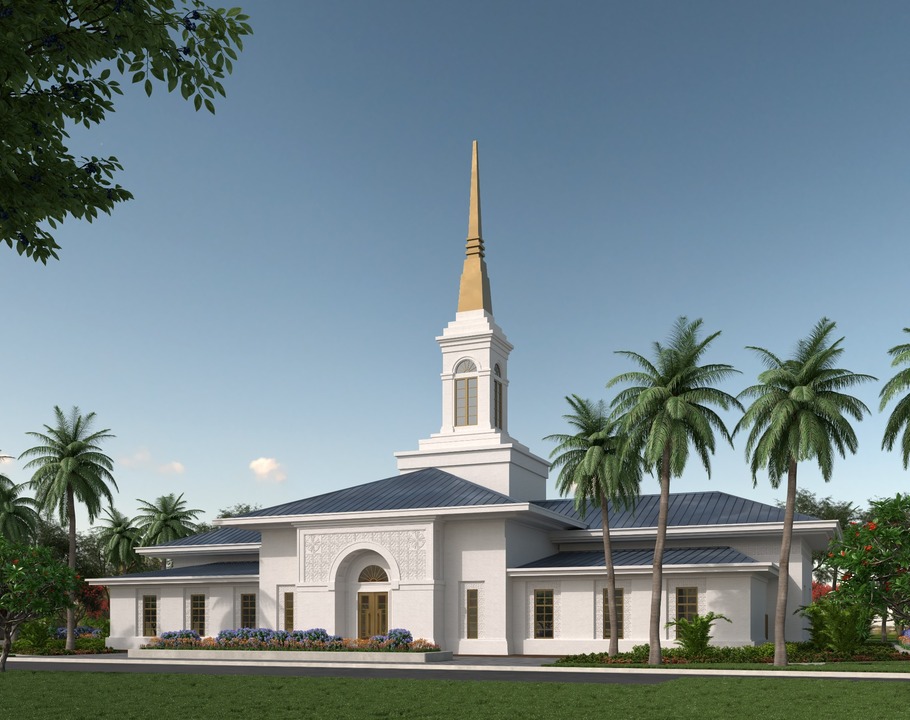Neiafu Tonga Temple
On 7 April 2019, at the closing session of the 189th annual general conference of The Church of Jesus Christ of Latter-day Saints, President Russell M. Nelson announced that a new temple will be built in Tonga. The Neiafu Tonga Temple will be the second temple built in Tonga, following the Nuku'alofa Tonga Temple (1983).
Tonga has the highest percentage of Latter-day Saints of any country in the world. With a population of approximately 108,000 people, 65,500 are members of The Church of Jesus Christ of Latter-day Saints.
Neiafu is located on the island of Vava'u on the northern side of Tonga. There are four stakes operating on the island of Vava'u. Currently, members have to take either a 90-minute flight or an overnight ferry from Neiafu to the Nuku'alofa Tonga Temple.
The Neiafu Tonga Temple will be a single-story building of approximately 17,000 square feet. A distribution center will be constructed on site in addition to housing for the temple president and matron and for temple missionaries.
On 14 August 2020, the official rendering of the Neiafu Tonga Temple was released and the location of the temple was announced. The temple will be constructed on Tu’i Road at the site of the Church-owned Saineha High School. No school buildings will be impacted by the construction of the temple.
Contents
History of the Church in Tonga
In the western South Pacific, the kingdom of Tonga is a constitutional monarchy whose population speaks Tongan and English. Tongans are Free Wesleyan, Latter-day Saints, Roman Catholic, Church of Tonga, and Free Church of Tonga.
The first missionaries of The Church of Jesus Christ of Latter-day Saints sent to Tonga were Brigham Smoot and Alva J. Butler, sent by Samoan Mission President William O. Lee. They arrived on 15 July 1891 and soon met with King Jiaoji (George) Tubou and received permission to preach. They acquired property, erected a mission home and school, and purchased a boat to travel between islands. The first convert was Alipate, who was baptized on 15 July 1892. However, the mission made little progress and was closed in 1897.
Missionary work resumed in 1907 by William O. Facer and Heber J. McKay under the direction of the Samoan Mission. They opened a school in Neiafu on the island of Vava'u, and by 1908, there were 28 day students and 13 night students. Facer later went to Ha'alaufuli where he was successful in organizing a branch with 32 converts. Missionary work opened on the main island of Tongatapu on 17 March 1911, and by December 1912, a meetinghouse and school had been completed and a conference organized. The Tongan Mission was reopened on 11 May 1916 with the arrival of a new mission president, Willard L. Smith.
Tonga became a protectorate of Great Britain following World War I and missionaries experienced problems obtaining visas. Consequently, the number of missionaries in Tonga declined. In 1921, Elder David O. McKay of the Quorum of the Twelve Apostles visited Tonga, but was quarantined on a nearby island for 11 days before he was allowed to enter the country. This hindrance was the result of anti-Mormon influences on Tongan government officials, culminating in the passage of an exclusion law in June 1922. The exclusion law prohibited Latter-day Saints from entering Tonga. The continued denial of visas to missionaries led to the calling of locals to do missionary work and serve in positions of leadership. The exclusion law was repealed in 1924 due to the efforts of mission president M. Vernon Coombs. Shortly after the law's repeal, Coombs obtained a property lease on which he started a school, called The Makeke school, meaning "arise and awake." The school opened in 1926 and became the foundation for an enlarged school system in later years. The use of local missionaries continued through the 1930s and 1940s.
Elder George Albert Smith of the Quorum of the Twelve Apostles visited Tonga 10 May-8 June 1938. His encouragement and teaching had an inspiring effect on the missionaries and members resulting in 117 new members being baptized in 1938. The Tongan Mission did not have more than 100 convert baptisms in a given year until 1954.
All foreign missionaries were called home during World War II, but many Latter-day Saint servicemen were stationed on Tongatapu and attended local meetings. After the war, foreign missionaries were once again restricted from entering Tonga, with the exception of the mission president and his family. Publication of the Book of Mormon in 1946 helped strengthen the Church. Membership in Tonga in 1946 was 2,422. Mission presidents called local missionaries in what became one of the most successful local missionary programs in the Church.
Much of the progress on the islands has been through Church schools. The establishing of schools in 1892 and 1908 proved significant, and led to other schools starting. The Makeke School was the principal method of advancing the Church for many years. In 1947, the Church obtained the lease on a 276-acre plantation outside of Nuku’alofa not far from Makeke to build an expanded school campus named “Liahona.” Liahona High School opened in 1952. Building the school represented the beginning of the Church’s labor missionary program and probably the catalyst for expansion of the Church in Tonga.
Between 1952 and 1968, the Church in Tonga grew from 3,280 members to almost 12,000, due in part to strong local priesthood leadership in the branches, the reputation of Liahona High School in attracting non-Mormon youth to attend – a high percentage of which eventually joined the Church – and the training of unmarried young Tongans to serve on local missions.
The Nuku'alofa Stake, Tonga’s first stake, was created on 5 September 1968 with Orson H. White as president. After that, the Church in Tonga was led almost exclusively by local members, including its mission, many of the schools, and the stakes.
